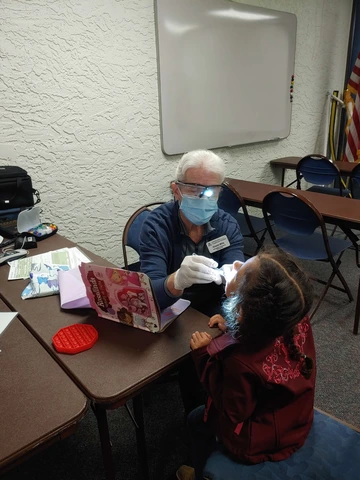Extension research laid foundation for current dental health protections
Arizona Experiment Station researcher Margaret Cammack Smith helped foster global changes in water treatment that protect millions of people from tooth damage. Today, Extension's First Smiles program is still protecting children's teeth.

University of Arizona Special Collections
In the early decades of the 20th century, Cooperative Extension nutrition scientist Margaret Cammack Smith saw a troubling problem with Arizona residents’ teeth.
People in some communities, including St. David, Sacaton, Thatcher, and Florence, had brittle and irregularly colored teeth, which was also a problem in parts of Asia, Europe, South America, and Africa. In the late 1920s, Smith, who was a chemist, was working for the Arizona Experiment Station.
She and fellow College of Agriculture researchers Edith M. Lantz and H.V. Smith conducted a study in the small community of St. David and found that everyone born and raised there had mottled teeth, according to their 1931 technical bulletin, “The Cause of Mottled Enamel, a Defect of Human Teeth.”

Cooperative Extension's Greeta Mills offers dental exams and fluoride treatments to children up to age 5
After ruling out diet and genetics, the researchers zeroed in on the amount of fluorine in drinking water. They ultimately reached a simple conclusion that remains a pillar of dental health for millions of people.
“Definite proof has been advanced to show that mottled enamel, a defect of the enamel of human teeth, prevalent in many parts of the world, is caused by the destructive action of fluorine present in the water supply of the afflicted communities,” the researchers wrote.
Also, in the early 1930s, H. Trendley Dean, a National Institutes of Health dentist, discovered that at low levels, sodium fluoride, a compound containing fluorine, makes teeth hard but doesn’t cause the mottling or cracking. By 1945, Dean’s research had convinced officials in Grand Rapids, Michigan to add fluoride to the water supply, which over the next 11 years reduced the incidence of cavities in children by 60 percent, according to the National Institute of Dental and Craniofacial Research.
Today, communities worldwide routinely regulate fluorine and fluoride in drinking water – removing the former or adding the latter as needed to protect our teeth. Despite those efforts, the effects that Smith saw lingered late into the 20th century, said Greeta M. Mills, a longtime dental hygienist who has spent the past six years in Extension’s Pinal County First Smiles program.
“It’s something I used to see in my practice – not so much anymore – in New Mexico. It was not uncommon for us to see families from ranches or farms or small communities where they had so much fluoride in the water that their teeth were mottled. They were hard as could be – they didn’t get cavities,” Mills said.
In recent decades, dental health has taken a blow from the foods we eat. Thirty years ago, dental professionals thought we would see a day when children did not have cavities.
“We really thought that was going to happen. Then, on the nutritional end of things, we got slammed with sugar in every form and in everything,” Mills said.
Through First Smiles, which targets children up to age 5, Mills offers free dental exams, fluoride treatments, and education in Head Start programs, elementary schools, library story times, community events, and homes.
“We screen in the park. We screen in grandparents’ homes where they’re watching grandchildren, and it’s not just the screening. It’s also about the education,” Mills said.
She also works with pregnant mothers to head off tooth decay before it happens. Babies are not born with the bacteria that cause tooth decay; they get it from us. And the risk of dental decay in mothers goes beyond passing it to children, she said.
“If a pregnant woman has dental disease, the inflammation in the body can lead to pre-term labor. It can lead to low birth-weight babies, and that sets that child up from the very beginning trying to play catch-up,” Mills said.
Extension offers First Smiles in Pinal, Yuma, and Gila counties. The program is funded through First Things First, a state agency that is in turn funded by tobacco taxes and Arizona’s share of a multi-billion-dollar settlement reached in 1998 in which tobacco companies agreed to reimburse states for the costs of smoking.
Though dental science has come a long way in the past century, connecting that science to communities through educational programs like First Smiles is vital to reducing the lingering impact of tooth decay, Mills said.
“It’s still the number one chronic disease of children, and more than 50 percent of our kindergartners have had decay experience … and it’s preventable.”

